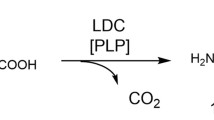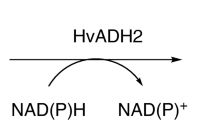Abstract
An alternative approach to the regeneration of coenzymes is described here using immobilized microorganisms possessing “NADH-oxidase” function. Bacteria containing NADH-oxidase activity are immobilized by microencapsulation within artificial cells. In this form, the microencapsulated bacteria can recycle NADH back to NAD in the presence of molecular oxygen as an electron acceptor. The only byproduct of the recycling reaction is water. In order to perform the biological regeneration of NAD, the activity of NADH-oxidase was investigated in 13 strains of aerobic bacteria and yeast. The NADH-oxidizing bacteriaLeuconostoc mesenteroides exhibited the highest activity among the microorganisms tested. The permeabilized bacteria showed 10% of their initial activity after microencapsulation. Light and electron microscopy studies of bacteria loaded microcapsules have been done. Enzymatic properties of microcapsule-immobilized bacteria were investigated in comparison with those of the free enzyme complex.Leuconostoc mesenteroides, containing NADH-oxidase, has been microencapsulated together with 3α-hydroxysteroid dehydrogenase (3α-HSDH) for stereospecific steroid oxidation.
In a batch reactor, 2 mg of NAD, with recycling, allowed the same substrate consumption as 4.4 mg of NAD without recycling. The microencapsulated system can be used repeatedly. The system is functional for 10 h, during which time each molecule of NAD has been used 7.6 times.
Similar content being viewed by others
References
Chang, T. M. S., Yu, Y. T., and Grunwald, J. (1982),Enzyme Eng. 6, 451.
Wykes, J. R., Dunnill, P., and Lilly, M. D. (1975),Biotechnol. Bioeng. 17, 51.
Ergan, F., Atrat, P., Dhulster, P., Gellf, G., Kim, M. N., Legoy, M. D., and Thomas, D. (1982),Z. Allgem. Mikrobiol. 22, 9, 607.
Coughlin, R. W., Aizawa, M., Alexander, B. F., and Charles, M. (1975),Biotechnol. Bioeng. 17, 515.
Kawai, K., and Eguchi, Y. (1975),J. Ferment. Technol. 53, 8, 588.
Gwak, S. H., Ota, Y., Yagi O., and Minoda, Y. (1982),J. Ferment. Technol. 60, 3, 205.
Chang, T. M. S. (1964),Science 146, 3643, 524.
Chang, T. M. S., MacIntosh, F. C., and Mason, S. G. (1966),Can. J. Physiol. Pharmacol. 44, 115.
Chang, T. M. S. (1972), inArtificial Cells, 1st edn., Charles C Thomas, Springfield, IL, USA, p. 207.
Chang, T. M. S. (1977), inBiomedical Applications of Immobilized Enzymes and Proteins, vol. 1, Chang, T. M. S., ed., Plenum, New York, pp. 93–147.
Author information
Authors and Affiliations
Rights and permissions
About this article
Cite this article
Ergan, F., Thomas, D. & Chang, T.M.S. Selection and microencapsulation of an “NADH-oxidizing” bacterium and its use for NAD regeneration. Appl Biochem Biotechnol 10, 61–71 (1984). https://doi.org/10.1007/BF02783736
Received:
Accepted:
Issue Date:
DOI: https://doi.org/10.1007/BF02783736
Index Entries
- NAD+ recycling, and microencapsulation
- hydroxysteroid dehydrogenase, microencapsulation of
- microencapsulated bacteria
- “NADH-oxidase”
- immobilization, of an NADH-oxidizing bacterium
- immobilized multienzyme, microencapsulated
- enzyme, microencapsulation and regeneration of
- biotechnology, and NAD regeneration
- artificial cells, and NAD regeneration




